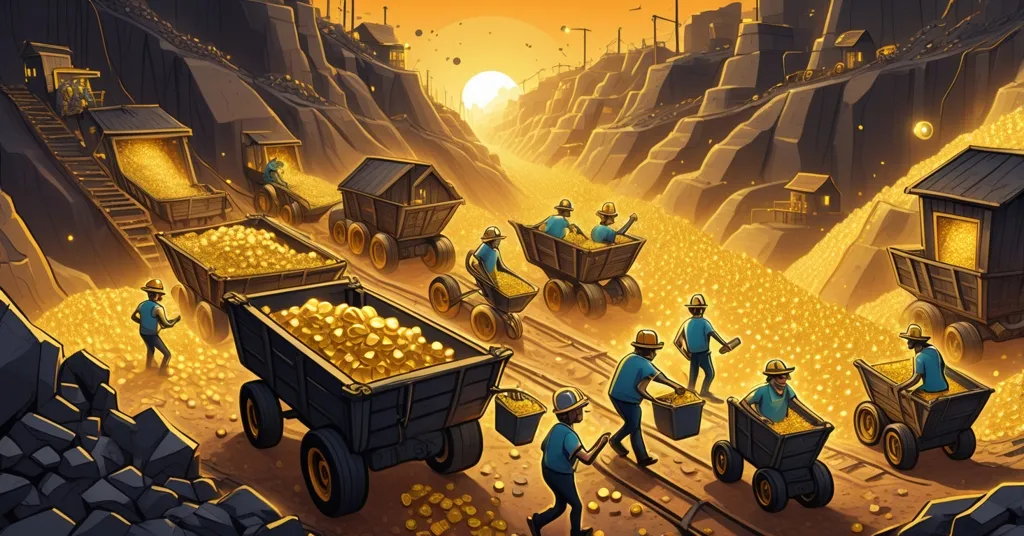Mining Companies Raise $2.9B in Historic Surge: Lessons for Bitcoin and Crypto Hype

Mining Companies Smash Decade-High Capital Raise: A Mirror for Bitcoin and Crypto Frenzy
North American mining companies just pulled off a jaw-dropping feat, raising $2.9 billion in October across 185 deals—the highest monthly haul in over a decade. While gold and silver prices stumbled mid-month, investor mania for precious metals and critical minerals remains red-hot, echoing the wild speculative rushes we’ve seen in Bitcoin and crypto markets. What does this gold rush mean for the digital gold of our space, and are there warnings we should heed?
- Historic Haul: Miners raised $2.9 billion in October, a peak not seen since November 2013.
- Small Players, Big Wins: Junior miners, not industry titans, led the charge in equity deals.
- Crypto Parallels: The hype mirrors Bitcoin mining investment booms, with shared risks and opportunities.
The $2.9 Billion Mining Boom: Breaking Down the Numbers
According to Bloomberg data, October marked a historic moment for North American miners, with capital raises hitting levels unseen since the early 2010s. Gold and silver miners snagged a third of these equity deals—basically, sales of company shares to investors to fund operations or growth—even as prices for these metals dipped after October 21. This kind of resilience in the face of price pullbacks smells a lot like the stubborn optimism during Bitcoin’s volatile bull runs, where miners like Riot Blockchain or Marathon Digital raised millions despite looming crashes or regulatory storms.
What’s surprising is who’s driving this surge. It’s not the heavyweights like Newmont Corp., a U.S.-based giant that’s doubled in value this year and still ranks among the top ten on the S&P 500. Instead, it’s the junior miners—smaller, often exploratory companies with high growth potential but also higher risks compared to established players. These underdogs are scrambling for cash to stake their claim while the market’s hot, much like early-stage crypto projects during the 2017 ICO craze. NexGen Energy Ltd., a uranium miner listed in Toronto, New York, and Sydney, raked in C$400 million ($287.2 million) through a bought deal—think of it as a pre-arranged bulk share purchase by investors for quick capital—and an upsized A$600 million ($395.9 million) sale in Sydney. Meanwhile, Hycroft Mining Holding Corp., a Denver-based gold and silver producer, secured $171.4 million, the month’s biggest precious metals deal. These aren’t names you’d recognize at the dinner table, but they’re cashing in big, as mining firms hit a decade-high pace in raising capital despite fluctuating gold prices.
Investor enthusiasm is borderline delirious. Daniel Nowlan, Vice-Chairman at National Bank Capital Markets, couldn’t hold back his amazement at the market’s strength:
“I can’t even think of a deal that’s struggled for the last while. Almost everything’s been oversubscribed—many deals have been upsized, so the market’s been very strong.”
Peter Miller, Head of Equity Capital Markets at Bank of Montreal—the top advisor on mining deals that month—pointed out that this wave is “entirely dominated by a plethora of junior miners.” If that doesn’t scream underdog story, what does?
Bitcoin Mining vs. Traditional Mining: Same Hype, Different Game
Let’s talk parallels. Just as junior miners are riding a wave of investor cash tied to metal price hype, Bitcoin mining companies have historically capitalized on BTC price rallies to fund massive expansions. During the 2021 bull run, firms like Riot Blockchain raised hundreds of millions through equity offerings to buy more rigs—those specialized computers that solve complex math to secure the Bitcoin network and earn rewards. But here’s the rub: Bitcoin miners face unique headaches that gold diggers don’t. Think skyrocketing electricity bills—mining rigs guzzle power like a fleet of 747s—and regulatory heat, with governments from China to the U.S. cracking down over environmental concerns or financial oversight. Traditional miners are tied to physical geography; Bitcoin miners can, in theory, relocate to cheaper grids, as seen with Riot’s pivot to Texas for excess energy deals. Yet both sectors share a reliance on speculative sentiment. When prices soar, investors throw money at anything that glitters—be it gold or digital gold.
The Fear of Missing Out (FOMO) is the real engine here. Michelle Khalili, Global Head of ECM at Bank of Nova Scotia, nailed it when she said:
“If you were an investor this year that didn’t have appropriate exposure to the sector, you will have lagged from a performance perspective.”
It’s the classic trap: piling in late like lemmings, terrified of missing the next moonshot—whether it’s gold hitting all-time highs or Bitcoin blasting past $60,000. Spoiler alert: plenty get wrecked when the music stops. We’ve seen it in crypto with the 2017 ICO bubble, where countless altcoin projects turned out to be scams or vaporware, and we’re seeing echoes now in mining’s frothy deal spree.
Critical Minerals and Strategic Plays: A Blockchain Opportunity?
Beyond gold and silver, the mining boom extends to critical minerals like copper, which are fetching near-record prices. These aren’t just shiny trinkets; they’re the backbone of tech and green energy—think copper wiring in electric vehicles or lithium in batteries. U.S. government support, through policies like the Inflation Reduction Act, is fueling deals by incentivizing domestic production to secure supply chains amid geopolitical tensions. John Ciampaglia, CEO at Sprott Asset Management, put it bluntly:
“We haven’t seen that much capital come into the space in a long time.”
For us in the crypto space, this opens a fascinating door. Blockchain technology, especially on platforms like Ethereum, has long been touted for supply chain transparency. Imagine a decentralized ledger recording every step of a mineral’s journey—from mine to market—visible to all and tamper-proof, unlike paper records ripe for fraud. Projects like IBM’s blockchain for food traceability could be a model for mining, ensuring ethical sourcing and verifiable data. With governments pushing for secure, domestic mineral supplies, the demand for such solutions could skyrocket. It’s a chance for blockchain to prove its worth beyond finance, aligning with our push for decentralization and disrupting outdated systems.
But let’s not get carried away. Skeptics argue blockchain adoption in traditional mining isn’t a slam dunk. Setup costs are steep, many old-school firms barely understand email let alone smart contracts, and some might resist transparent ledgers that could expose shady practices. Plus, there’s the irony: Bitcoin mining’s notorious carbon footprint—think millions of tons of CO2 annually—clashes with green mining goals. Still, the potential is there, and effective accelerationism demands we push these innovations hard, even if the road’s bumpy.
Bubble Risks and Shared Lessons: Don’t Let FOMO Dig Your Grave
Looking ahead, the mining sector shows no signs of cooling. Subash Chandra, an analyst at Benchmark Co., warned of a “competitive froth” as companies rush to market via IPOs, SPACs, or more equity sales:
“You are going to see a lot of these companies come to market, IPO, SPACs, raise equity. They’re all going to be in this competitive froth to get to market first.”
If that doesn’t scream 2017 crypto mania, I don’t know what does. Back then, every half-baked token project was begging for cash, and the fallout—think 80% of ICOs failing or rug-pulling—was brutal. Traditional mining might not have digital scams, but overvaluation and market saturation are just as real. Hype inflates bubbles—until they pop, leaving suckers holding the bag, whether it’s overpriced gold stocks or a crashed altcoin you can’t even pawn.
Bitcoin maximalists like myself see a clear edge here. Gold’s allure as a store of value is undeniable—hell, it makes up 12% of Canada’s S&P/TSX Composite Index—but its physical nature ties it to centralized oversight and logistical limits. Bitcoin, on the other hand, flips the bird at borders and middlemen with its censorship-resistant, decentralized design. Yet both markets reveal the same human flaw: chasing the next big thing, often blind to the cliff ahead. Crypto’s learned this the hard way, from China’s 2021 mining ban gutting hash rates to DeFi exploits draining billions. Mining’s current frenzy might be a cautionary tale—build fast, sure, but build smart, or you’re just digging a deeper hole.
Could Partnerships Be the Next Frontier?
Here’s a wild thought: what if blockchain innovators and traditional miners teamed up? Tokenizing mining assets on Ethereum or Solana could let retail investors buy fractional shares of a gold mine, democratizing access in a way equity deals can’t. Or use blockchain to certify ethical sourcing—say, proving copper isn’t tied to conflict zones—adding value for eco-conscious buyers. It’s not sci-fi; platforms like Harbor have toyed with asset tokenization, and supply chain projects on Ethereum already exist. The catch? Getting miners to buy into decentralization when they’re used to top-down control. Still, in a world hungry for disruption, it’s a bet worth making.
Key Takeaways and Reflections
So, what should Bitcoin and blockchain enthusiasts chew on from this mining bonanza? Here’s a breakdown of critical questions and insights to unpack the implications for our space:
- How does the mining capital surge compare to Bitcoin mining trends?
Both see massive cash inflows during asset price hype—junior miners raised $2.9 billion in October, much like Bitcoin miners raised millions in 2021. Yet BTC miners face unique energy and regulatory hurdles that physical mines sidestep. - Can blockchain technology boost transparency in traditional mining?
Yes, decentralized ledgers could track equity deals and mineral sourcing, slashing fraud risks. Think Ethereum-based records ensuring a mine’s output isn’t tied to unethical practices—a game-changer for trust. - What’s the overlap between FOMO in gold and Bitcoin markets?
Investors in both rush in late, driven by store-of-value narratives amid economic uncertainty. Gold offers tangibility; Bitcoin brings digital programmability and borderless freedom, but the panic-buying psychology is identical. - Will U.S. support for critical minerals spur blockchain adoption?
Quite possibly—government focus on secure supply chains for tech like EVs could drive demand for blockchain traceability solutions, benefiting protocols on Ethereum or others built for transparency. - Is the mining sector’s hype sustainable, and what’s the lesson for crypto?
Likely not. Overzealous raises risk bubbles, akin to crypto’s ICO flops. The takeaway for Bitcoin and DeFi is clear: prioritize sustainable growth over speculative frenzy, or crash and burn. - How do energy costs impact both traditional and Bitcoin mining?
Both grapple with hefty electricity bills, but Bitcoin miners have flexibility to chase cheap power grids, unlike physical mines locked to geography. Still, sustainability pressures hit hard across the board. - Are junior miners a safer bet than early-stage crypto projects?
Not really—both carry high failure risks. Mining offers tangible assets as a fallback; crypto often hinges on speculative code or unproven tech, making due diligence non-negotiable in either space.
Zooming out, the mining boom and crypto’s parallel frenzies boil down to a shared truth: humans will always chase value, whether it’s buried in the earth or coded on a blockchain. The $2.9 billion haul by miners is a stark reminder of both the power and peril of hype. For us championing decentralization, privacy, and financial revolution, it’s a call to reflect. Are we crafting lasting infrastructure with Bitcoin and innovative protocols, or just stacking another house of cards? As both sectors race forward, that question looms larger than any gold nugget or satoshi.



